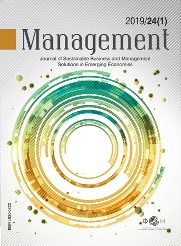Employee and the Self-Employed Job Satisfaction: Similarities and Differences
Employee and the Self-Employed Job Satisfaction: Similarities and Differences
Author(s): Nebojša Janićijević, Katarina Ignjatović PaunovićSubject(s): Economy
Published by: Fakultet organizacionih nauka Univerziteta u Beogradu (FON)
Keywords: job satisfaction;self-employment; small firm; job dimensions; autoonomy at work; Serbia;
Summary/Abstract: Research question: This paper investigates if there are differences between employees and the self-employed job satisfaction levels. Motivation: The motive for this research was the desire to determine the validity of the assumption that the self-employed are more satisfied with their jobs than employees, and also to investigate for the first time in Serbia the differences in the self-employed and employee job satisfaction. The paper relies on earlier research works that have all shown that the self-employed are more satisfied with their jobs than employees (Blanchflower, 2004). This is due to the autonomy at work that the self-employed have, while employees experience it in a smaller degree. In addition, the selfemployed also have better opportunities to organize their work so that it can be interesting, a greater flexibility at work and larger income. Idea: In this perspective, the central hypothesis of this study is that in Serbia, and also other researched countries, the self-employed job satisfaction is higher than that of the employees in their firms. Therefore, the research has been directed to determine whether job satisfaction, as a dependent variable, is systematically different depending on the respondents’ status (self-employed – employee), as an independent variable. Data: The research included 127 employees in 15 different business firms run by the self-employed from different parts of Serbia. Of the total number of respondents, 52 were self-employed while 75 were employees. The respondents rated the importance of and their satisfaction with 12 job dimensions. Tools: While calculating the average importance and satisfaction rates of the self-employed and employees, as well as the statistical significance of the differences in their ratings by means of independent sample t test, significant results have been obtained. Findings: Just like in the earlier research, it has been confirmed that the self-employed show a higher level of total job satisfaction in comparison with employees. Statistically significant differences in the job dimensions’importance exist only in the job dimension “Work that does not require overtime”, which is significantly more important to employees than to the self-employed. With respect to job satisfaction, statistically significant differences exist in 6 out of 12 job dimensions, and in each of them the self-employed are more satisfied than the employees. Unlike in earlier research, the main source of the self-employed satisfaction is not autonomy at work, but personal responsibility in task completion, safe working conditions and friendly atmosphere at work. Contribution: The study has once again shown that the selfemployed are more satisfied with their job in comparison with the employees, and that this also applies in Serbia.
Journal: Management: Journal of Sustainable Business and Management Solutions in Emerging Economies
- Issue Year: 24/2019
- Issue No: 1
- Page Range: 43-53
- Page Count: 10
- Language: English

